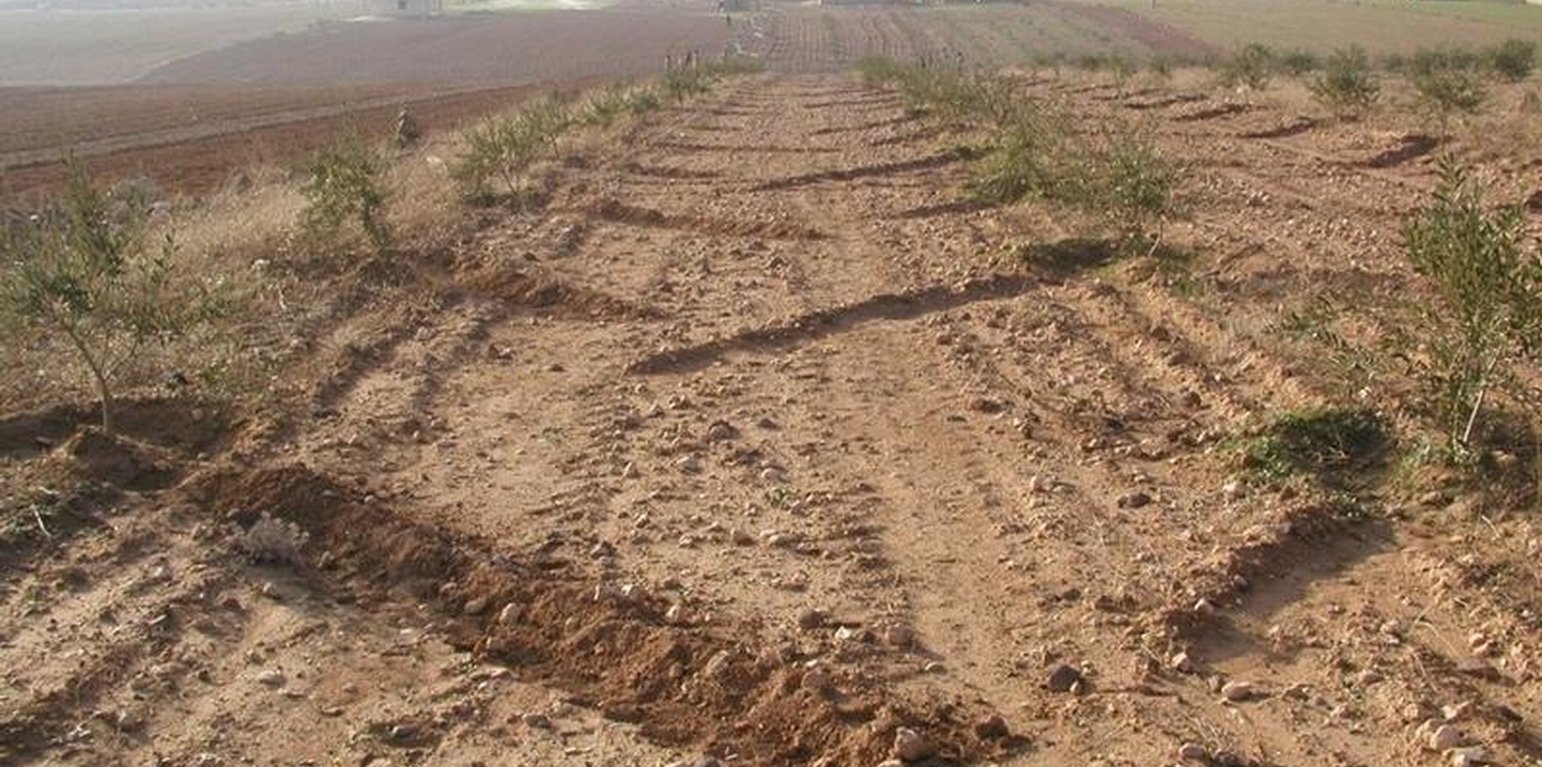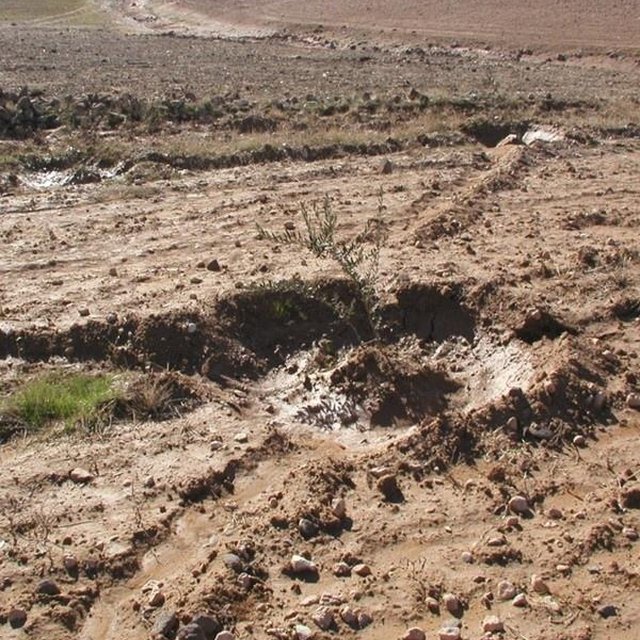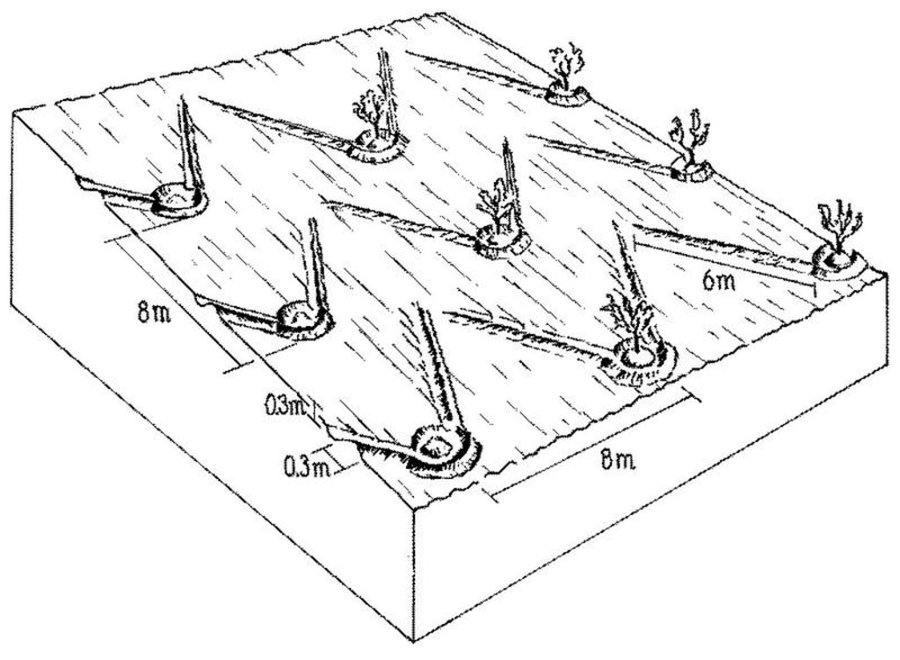



The Khanasser Valley in north-west Syria is a marginal agricultural area, with annual rainfall of about 220 mm/year. Soils are shallow and poor in productivity. The footslopes of degraded hills are traditionally used for extensive grazing or barley cultivation. However to achieve self-sufficiency in olive oil production, several farmers have developed orchards in this area - which is generally considered too dry for olives.
Trees are spaced at 8 m apart, within and between rows. Traditionally, farmers prefer to till their orchards by tractor in order to keep them weed-free (weeds may attract sheep, lead to fires and compete for water with the olive trees). As this tillage operation is usually practised up and down the slope, the resulting furrows stimulate runoff and erosion. However, when this is combined with Vshaped and/or fish-bone shaped microcatchments around individual trees, the furrows created can be used to harvest runoff water for improved production.
The V-shape earthen bunds (reinforced with some stones) are constructed manually, by hoe, around each tree. The furrows then divert runoff systematically to the microcatchments where it concentrates in basins around the trees. Each tree is effectively served by a catchment area of 60 m2. The catchment: cultivated area ratio is thus approximately 60:1 (assuming the area exploited by the tree.
This technology saves irrigation water during the dry season, enhances soil moisture storage, and stimulates olive tree growth. Furthermore, fine particles of eroded soil are captured in the microcatchments. While these may be nutrientrich, they also tend to seal the surface. The bunds need to be rebuilt every year. If the structures are damaged after a heavy storm, they need to be repaired. Labour input for establishment and maintenance is low, the technology is easy and cheap to maintain, and there is enough local skill to sustain and expand the system. A supporting technology is to mulch the area around each tree with locally available stones (limestone and/or basalt) to reduce soil temperature during the summer, decrease surface evaporation and improve infiltration. The catchment areas between the trees are sometimes planted with low water-demanding winter annuals (lentils, vetch, barley, etc) especially when the trees are young. This helps to reduce surface erosion. Implementation of furrow-enhanced runoff water harvesting in olive orchards started in 2002, and adoption by farmers is growing gradually.

สถานที่: Khanasser Valley, Aleppo, NW Syria, ซีเรีย
ตำนวนการวิเคราะห์เทคโนโลยี:
การเผยแพร่ของเทคโนโลยี:
In a permanently protected area?:
วันที่ในการดำเนินการ:
ประเภทของการแนะนำ










| ปัจจัยนำเข้า | หน่วย | ปริมาณ | ค่าใช้จ่ายต่อหน่วย (n.a.) | ค่าใช้จ่ายทั้งหมดต่อปัจจัยนำเข้า (n.a.) | %ของค่าใช้จ่ายที่ก่อให้เกิดขึ้นโดยผู้ใช้ที่ดิน |
| แรงงาน | |||||
| Construction (10 person days) | ha | 1.0 | 50.0 | 50.0 | 100.0 |
| อุปกรณ์ | |||||
| Machine use | ha | 1.0 | 10.0 | 10.0 | 100.0 |
| Tools | ha | 1.0 | 3.0 | 3.0 | 100.0 |
| วัสดุสำหรับก่อสร้าง | |||||
| ค่าใช้จ่ายทั้งหมดของการจัดตั้งเทคโนโลยี | 63.0 | ||||
| Total costs for establishment of the Technology in USD | 63.0 | ||||
| ปัจจัยนำเข้า | หน่วย | ปริมาณ | ค่าใช้จ่ายต่อหน่วย (n.a.) | ค่าใช้จ่ายทั้งหมดต่อปัจจัยนำเข้า (n.a.) | %ของค่าใช้จ่ายที่ก่อให้เกิดขึ้นโดยผู้ใช้ที่ดิน |
| แรงงาน | |||||
| Repair (5 person days) | ha | 1.0 | 25.0 | 25.0 | 100.0 |
| ค่าใช้จ่ายทั้งหมดของการบำรุงรักษาสภาพเทคโนโลยี | 25.0 | ||||
| Total costs for maintenance of the Technology in USD | 25.0 | ||||
Through water saving
Increase in soil fertility
Increased weed growth around trees